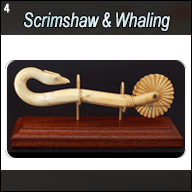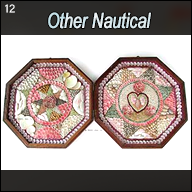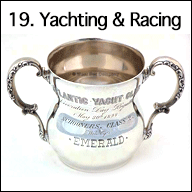19. Yachting & Racing
Prices in U.S. Dollars are in GREEN
 |
13.19/19.94 YACHT CLOCK. Especially nice 19th century yacht salon clock with the silvered brass dial engraved “BENZIE COWES” underneath the winding arbor. The lovely dial has bold Roman numerals and a minute chapter ring swept by blued steel spade hands. Around the center arbor the dial is decorated with hand-engraved floral motifs. The Fast/Slow adjustment it made within the XII. The all brass clock mechanism is most unusual. It consists of a plain balance wheel with coiled hairspring with a lever escapement. But what is remarkable different from most such escapements is that the escape pallet is mounted on a long rod passing through the back plate and is in line with the motion work wheels below. The Fast/Slow adjustment is also very unusual, being another long rod passing from the dials to a lever on the balance cock above the jeweled top pivot. It is marked F / S.” The back plate is marked within an oval “V.A.P. BREVETÉ S.C.D.G.” Complete with period winding key. This is a splendid example of traditional Victorian melding of form and function in that era, prone to extravagance. This clock was not only a handsome addition to the elaborate décor of the yacht’s salon, it provided a valuable real time reference. 649 Simpson Benzie was listed as a clockmaker working in West Cowes, Isle of Wight, England form 1867-1878. (Brian Loomes, “Watchmakers & Clockmakers of the World, Volume 2,” 1978, N.A.G. Press, London). Cowes has been seen as the home for international yacht racing since the founding of the Royal Yacht Squadron in 1815. It is perhaps best known for the running of the first “All Nations Cup” held on August 22, 1851 around the Isle of Wight off Southampton and Portsmouth in a fleet race between the New York Yacht Club’s AMERICA and 15 yachts of the Royal Yacht Squadron. The race, witnessed by Queen Victoria, was won handily by the schooner yacht AMERICA. It is now considered to be the first “America's Cup” race, the most prestigious perpetual international yacht race in the world.. |
 |
 |
| perspective | dial |
 |
 |
| movement | back |
 |
19.38 YACHT WEATHER STATION. Absolutely charming turn-of-the-century weather station of pre-War German manufacture. This diminutive set is of the highest quality. It features 3 instruments: barometer, thermometer and hygrometer. The barometer has a multi-color hard-fired porcelain dial calibrated in inches of atmospheric pressure from 27.5 to 31.5 in 2/100th increments marked by 10ths. Whole inches, 28 through 31, are identified. The dial bears the standard weather indications “Stormy RAIN Change Fair and Very Dry.” The bottom of the dial is marked “Germany.” A fine blued steel indicator needle points to the reading. It is overlaid by the brass set needle rove through the beveled glass crystal to a knurled brass knob. The brass barometer body is attached to the mount with 3 screws. At the center is the delicate mercury thermometer mounted to its milkglass scale reading in degrees Centigrade and Fahrenheit. The centigrade scale runs from - 8 to 46 and the Fahrenheit scale from 26 to 114. The hair hygrometer reads from “0 Dry” to “100% Moist.” The brass body is protected by the beveled glass crystal. All three instruments are mounted to the rich mahogany oval backboard. It has 2 brass hanging brackets for mounting and measures 8 by 4 ¾ inches. Outstanding original condition in all respects. All functions are guaranteed to be working and accurate. This is the first such instrument of this quality we have had the pleasure of offering in our 40+ years. 485 |
 |
 |
| HYGROMETER | barometer |
 |
| back |
 |
19.93 YACHT RACE TROPHY. Unique American racing trophy in the form of a hand-engraved pewter stein dated 1901. The front is beautifully engraved with the inscription reading “WARWICK YACHT CLUB, DORY CLASS, September 7, 1901 Won By Fred Mason.” This substantial trophy is solid pewter with a classic glass bottom. It is of traditional form with serpentine handle, sloping sides and decorative bands top and bottom. The base is marked “BANNING BOWMAN & CO. 176.” It measures 5 ¼ inches high by 6 1/4 inches wide inclusive of the handle and 4 5/8 inches in diameter at the base. Excellent original condition throughout with a nice age patina, noting some wear to the handle. A rare yacht racing trophy over 120 years old at the ridiculously low price. 169 |
 |
 |
| reverse | glass bottom |
 |
| inscription |

|
19.92 REGATTA YACHT TROPHY. Unusual early 1900's American yacht racing trophy in the form of an ashtray with a compass in the middle. The bowl of the ashtray is professionally hand-engraved "BOSTON INTERCOLLEGIATE REGATTA FALL 1940 R. P. KNAPP." Colleges in the Boston area at the time included Harvard, Boston College, Northwestern University and M.I.T. – certainly the most revered schools in the country. This trophy is concave solid brass with an exceptional detailed knurled rim. The center piece is a very high quality magnetic compass card indicating the cardinal and intercardinal point of the compass, with the periphery calibrated in 5 degree increments marked by 10's. The center is embellished with a star and is marked "PATENT SWISS." The tray measures just under 7 inches in diameter and the compass is 1 1/8th. Outstanding original condition. The compass is very lively and accurate. A most unusual functional yachting trophy with a prestigious origin. 189 |
compass |

|
19.82 IMPORTANT YACHT PHOTO. Late 1800’s albumen photograph of the one and only American side wheel steam yacht, identified as the steam/sail CLERMONT underway in the midst of an America’s Cup race melee. This classic, well documented original photograph depicts the handsome yacht from a port side perspective in the foreground underway on steam amidst a sea of large and small spectator vessels craft intent on viewing the America’ Cup race. It old fashioned rocking beam engine is clearly visible as it emits a puff of steam. Another large side wheel excursion vessel is visible just behind CLERMONT, as are numerous details under magnification. The lovely vessel with raked funnel and masts flying pennants, has a decorative paddle box cover. She clearly flies the American ensign from the stern. This original photograph is identified lower left “821 CLERMONT” and is attributed to Henry Peabody. The image measures 7 by 9 inches and is matted under old wavy glass 9 ½ by 11 ½ inches sight. It is house in its original ornate oak frame with floral elements measuring 13 12/ by 15 ½ inches overall. Outstanding original condition. Ready to hang. 389
Henry Greenwood Peabody (1855-1951) was a photographer, lecturer and publisher of educational slides and films. He worked in virtually every photographic medium, lectured and published books that pictured the landscapes and scenery in which he specialized. Born in St. Louis, Missouri, Peabody attended college in New England and graduated in 1876. While a senior at Dartmouth he became interested in photography, producing views of the campus and scenes along the coast. First employed in Chicago, Peabody relocated to Boston where he opened a studio in 1886. He specialized in marine, landscape and architectural photography and served as the official photographer for the Boston and Maine Railroad and the Great Northern Railway. He photographed the America's Cup races and published "Representative American Yachts and The Coast of Maine." In 1898 he accepted a position with the Detroit Publishing Company, the largest postcard publisher in the United States. From 1900 to 1908, he served as field photographer on both the east and west coasts. From 1910 to the end of his career, Peabody produced photographs and slides of American landscapes which focused on national parks in the American West. He also gave illustrated lectures covering the Grand Canyon, California Missions, Yosemite and Mexico. By the early 1930s, he was making audio recordings synchronized with his slide shows. He died at his home in Glendora, California, at age 96. He was a charter member of The Photographers Association of America, Boston Camera Club, Atlantic Yacht Club of New York, Corinthian Yacht Club of Marblehead, Massachusetts, Appalachian Mountain Club, "Sons of the Revolution," Technology Society of Architects, and was awarded six first prize medals for photographic by Photographers Association of America. Henry G. Peabody's distinguished career as a professional photographer began in Boston in the 1880s, when he specialized in marine views. Peabody and Nathaniel L. Stebbins photographed the same races in the early 1890s,although Peabody's work is considered to have a somewhat more artistic quality. Only a few institutions are known to possess sizable numbers of Peabody's marine views. These include: the Peabody-Essex Museum of Salem, Massachusetts; the Library of Congress and the Historic New England Society. |
detail |
image |
back |
plate |

|
8.68/19.89 YACHT WHEEL WITH IDENTIFIED MAKER. Very handsome turn-of-the-last century steering wheel from a major yacht. This classic 6 spoke helm bears the inlaid brass maker's plate reading "American Engineering Company, Phila. PA." It is beautifully constructed with a hefty laminated rim consisting of teak inlaid with two concentric rings of a lighter blonde wood, either birch or maple, interrupted at the each spoke with inlays of mahogany. The spokes and spindles are of nicely turned oak. The hub is of heavy solid brass with a key way corresponding to the king spoke identified by the maker's label. This substantial ship's wheel measures 41 inches from spoke to spoke, 31 inches across the outer rim and weighs a hefty 24 pounds. Excellent condition with the original old finish, showing goods signs of use at sea, but no abuse. Price Request |
detail |
maker |
19.41 YACHT BOOK. Bill Robinson, "Legendary Yachts, The Great American yachts from Cleopatra's Barge to Courageous," 1978, David McKay Co., New York, 306 pages, hard cover with dust jacket. The title tells it all. This book, written by the former editor of "Yachting Magazine," is a comprehensive treatment of yachts in America begining with the Salem-built CLEOPATRA'S BARGE in 1816 through such names as AMERICA and CORSAIR, ending with Ted Turner's America's Cup winnerCOURAGEOUS in 1977. Copiously illustrated. Mint condition. 69 |
plate 1 |
plate 2 |

|
19.85 YACHTING TROPHY. Extremely nice early 1900’s yachting trophy in the form a classic fluted cup with decorated lip. Applied to the front is the cloisonné burgee of the San Diego Yacht Club encircled by a rope border. The bottom of the cup is marked “(W STERLING NH1-1.” 3 inches high by 2 ½ inches wide. No presentation. Perfect original condition. SOLD |
sterling |

|
19.84 YACHT RACE TROPHY. Lovely hand-made sterling silver loving cup. The outer bowl of the cup is beautifully engraved with the inscription: “SAN DIEGO The bottom of the cup is signed “JESSOP Sterling.” |
san diego 1924 |
maker |

|
19.79 YACHT BINNACLE. Exceptional, turn-of the-last-century American yacht binnacle with finest quality liquid card compass. The interior of the heavy brass bowl is marked “SOUTHWESTERN INSTRUMENT CO. SAN PEDRO, CALIF.” then with a circle “BAKER COMPASS CO. – MELROSE, MASS. U.S.A. – ESTAB. 1873 QUICK & STEADY”. The open face composition card is supported on bar magnets resting on a central agate pivot. The card is marked with the cardinal and intercardinal points of the compass further divided down to ¼ points. The periphery of the card is marked in single degrees 0 – 360. The north point is denoted by a 5 pointed star within a sun burst pattern. The compass body is extremely heavy duty, finished in its original black paint and serial numbered three times on the compass and gimbal ring with the matching number “17814.” The card itself measures 6 inches in diameter, the compass 7 ¼ inches and the gimbal ring 8 ½ inches in diameter. This is all contained within the thick-walled solid brass binnacle housing with a classic “mushroom” top and double burners. The glazed oval viewing port clearly shows the compass within. There is an opening in the top with a press-fit cover to admit ambient light. For night time use this binnacle is complete with both its oil burning sidelamps. These brass binnacle lamps have hinged doors with curved glass windows opening on a sliding pin lock. The bell-type chimneys are adjustable and are equipped with their folding bail handles with insulating wooden grips. Inside, the fonts and burners deserve special note. The burners are porcelain and are marked “HEZZANITH LONDON BURNER PATENT” and the wick advance knob is marked with an embossed 8-pointed star. They are backed by the original silvered brass parabolic reflectors and fitted with a small pivoting triangular handle to lift the font. The entire assembly stands 17 ½ inches tall by 17 inches wide at the widest. The heavy cast brass flange base is 12 ½ inches in diameter. Outstanding original cosmetic and functional condition in every respect. This is probably the best binnacle of its type we have offered in our 35 years in the nautical antique business. Price Request
|
HELMSMANS VIEW |
SIDE |
PERSPECTIVE |
COMPASS |
COMPASS CARD |
BINNACLE LAMP |
LAMP OPEN |
BURNER & FONT |
BURNER |













































